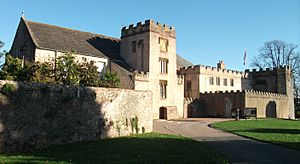Torre Abbey facts for kids

Exterior view
|
|
| Monastery information | |
|---|---|
| Order | Premonstratensian |
| Established | 1196 |
| Disestablished | 1539 |
| Architecture | |
| Heritage designation | Grade I listed |
| Site | |
| Location | Torquay, United Kingdom |
| Coordinates | 50°27′50″N 3°32′28″W / 50.464°N 3.541°W |
| Public access | yes |
Torre Abbey is a really old building and an art gallery in Torquay, Devon, in the South West of England. It started as a monastery in 1196. This was a place where a group of religious people called Premonstratensian canons lived and prayed. Today, it's the best-preserved medieval monastery in Devon and Cornwall.
Besides its old medieval and Georgian rooms, Torre Abbey is famous for its beautiful gardens. It also has the third largest art collection in Devon. Plus, it often shows new art by modern artists.
History of Torre Abbey

Torre Abbey was founded in 1196. Six Premonstratensian canons came from Welbeck Abbey in Nottinghamshire. They started the abbey when William Brewer, a rich lord, gave them land.
By 1536, Torre Abbey was the richest of all the Premonstratensian places in England. But in 1539, a big change happened. King Henry VIII decided to close many monasteries in England. This event was called the Dissolution of the Monasteries. The canons at Torre Abbey had to give up their home.
Soon after, Sir Hugh Pollard took over the abbey. He was a sheriff and a powerful person. In 1543, he bought the land completely.
After the abbey closed, much of the church was torn down. Valuable things like lead from the roofs were taken away. But some parts, like the south and west wings, were mostly saved. In 1598, these parts were turned into a house for Thomas Ridgeway.
Over the years, different families owned the house. In 1662, the Cary family took possession. They owned it until 1930. Then, Commander Henry Cary sold the house and grounds to the Torquay Borough Council. The Cary family still owned some of the land around it.
Since then, the building has been used as a public art gallery. It was also the mayor's office. During World War II, the Royal Air Force used it. Today, Torbay Council owns and manages Torre Abbey.
The abbey had a big makeover that cost £6.5 million. This was possible thanks to grants from the Heritage Lottery Fund and other groups. Torre Abbey reopened in July 2008, looking better than ever.
Buildings at Torre Abbey
The main abbey has two buildings that are very important. They are called Grade I listed buildings. This means they are historically very special.
The church is mostly a ruin now. But the west and south sides of the cloisters (covered walkways) are still standing. The gatehouse, which is the entrance building, was built around 1380. The chapel, which used to be a guest hall, has a special curved ceiling from the 1400s.
There's also a large barn called the tithe barn. It was built with the abbey in the early 1200s. This barn is famous as The Spanish Barn. This is because in 1588, it held 397 prisoners from the Spanish Armada for two weeks!
Around 1740, the buildings were changed a lot. They were given a Georgian style, which you can still see today. The Cary family also made more changes in the 1800s, even adding a small brewery.
A chapel called St Michael's Chapel is on top of Chapel Hill in Torquay. It might have belonged to the Abbey too.
Art Exhibitions
Torre Abbey has many interesting art pieces. The main art shows focus on paintings from the 1800s. These include important works by William Blake. There are also pieces by the Pre-Raphaelite artists. These include Edward Burne-Jones's The Planets series and William Holman Hunt's The Children's Holiday.
The Abbey also keeps all the art from the studio of Frederick Thrupp. He was a Victorian sculptor. This is the largest collection of a single Victorian sculptor's work in the UK.
Torre Abbey also hosts modern art shows. In 2009, they showed Antony Gormley's Field for the British Isles. In 2010, they had Damien Hirst's Mother and Child, Divided. Every year, the Torre Abbey Contemporary Open exhibition (TACO) shows art from artists in the South West.
Interesting Facts
From 1800 to 1801, Admiral John Jervis, 1st Earl of St Vincent lived at Torre Abbey. He was in charge of the Channel Fleet. He stayed there because he was too ill to be with his ships.




